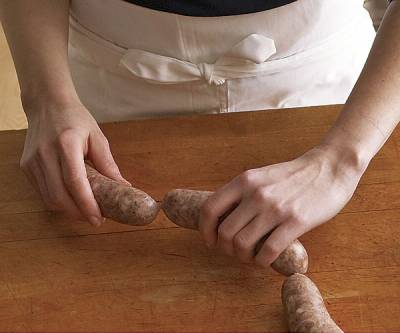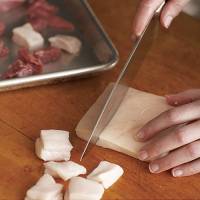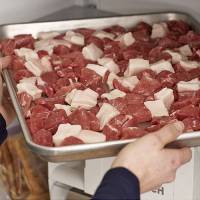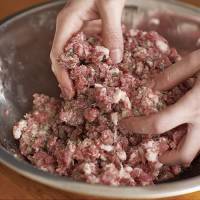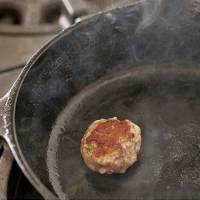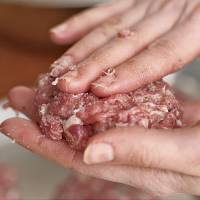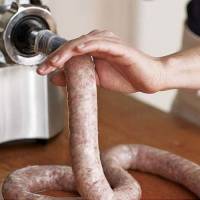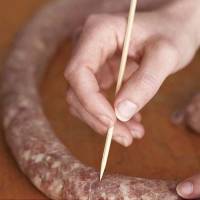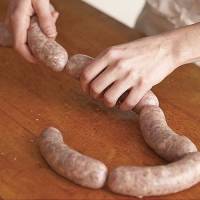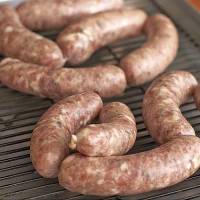Making Sausage
Part One: Grind It
1. Trim and discard any gristle or connective tissue from the pork. Cut the pork and pork fat back into 1-inch cubes.
2. Spread in an even layer on a rimmed baking sheet and put in the freezer, uncovered, until very cold (partially frozen on the edges but still soft in the center), about 1 hour. Meanwhile, chill a large mixing bowl and the blade and 1/4-inch grinding plate from your meat grinder.
3. Set up the meat grinder with the chilled parts according to manufacturer’s instructions. Grind the pork and the fat together into the chilled bowl. The mixture should come off the grinder cleanly, and the fat should not appear warm or smeared. If smearing occurs, return the meat and fat to the freezer until very cold.
Part Two: Mix It
1. In a small bowl, mix the salt, pepper, garlic, and sage. Add the seasonings and the wine to the ground meat and mix briefly but thoroughly with your hands. Don’t overmix, or the fat could begin to melt.
2. To taste for seasoning, make a small patty of the sausage mixture and cook it in a small skillet over medium-low heat. Taste and adjust the seasoning to your liking. If not shaping the sausages immediately, refrigerate until you’re ready to proceed.
3. For the simplest sausage, just mold the mixture into patties: use your hands to shape the patties about 2-1/2 to 3 inches in diameter and 3/4 inch thick.
You can stop right there and cook your sausage as patties, or, to form the sausage into links, continue with the stuffing process.
Part Three: Stuff It
1. Put the hog casings in a medium bowl and set it in the sink. Rinse the casings under cool running water: Hold one end of each piece of casing open under the tap and flush it out by gently running cool water through it. (Once you fill part of the casing, use your hands to push the water through to other end.) Fill the bowl with fresh, cool water and let the casings soak for 10 minutes.
2. Attach a 5/8- or 3/4 -inch sausage-stuffing tube to the front of your grinder or to a sausage stuffer. (If using a grinder with a stuffing attachment, be sure to remove the grinding plate and blade first.) Splash cool water onto the tube to moisten it. Open an end of one piece of casing and pull it over the end of the tube. Push the rest of the casing onto the tube accordion-style, leaving 3 or 4 inches hanging off the end.
Fill the hopper with the sausage mixture and feed it through just until it reaches the end of the stuffing tube. Check with your finger to feel if the meat is flush with the opening. Tie the end of the attached casing into a knot, and slide it up over the tube until the knot hits the tip of the tube.
3. Continue to feed the meat mixture through the tube to fill the casing, pressing your thumb and forefinger against the tip of the tube to control the rate and tightness of the filling. Go slowly, don’t overstuff (but do stuff firmly), and watch for air holes. When there are only 3 to 4 inches of empty casing left, stop the feeder, slip the casing off the tube and tie it in a knot about 1/2 inch from the end of the sausage filling—this extra space will fill in as you make links.
4. Use a skewer or toothpick to prick any air holes that have formed during stuffing. Repeat with the remaining casings and sausage mixture.
5. To make links, lay one sausage at a time on a clean work surface, with the front end of the sausage (the end where you began filling) in front of you and the rest of the sausage lying to the right. Measure 5 inches from left to right and pinch the casing at that spot between your thumb and forefinger. Twist the unlinked portion away from you at least 4 or 5 turns to bind off the link on the left. Measure another 5 inches and pinch and twist away from you to form another link. Repeat until you reach the end of the casing, always twisting in the same direction. Prick any remaining air holes.
6. Lay the links, uncovered, on a rack set over a rimmed baking sheet. Dry in the refrigerator for 24 hours to allow the flavors to meld and to give the casings a good bite when cooked. Drying will also reduce the amount of moisture in the meat, too much of which can steam and lead to bursting.
Tips
Keeping casings:
- Natural sausage casings come packed in salt or covered in brine. To store leftover salt-packed casings, squeeze out as much water as possible, and when fairly dry, cover them generously with kosher salt and refrigerate—they’ll last for up to a year this way.
- Brined casings will keep in their brine for up to six months in the refrigerator.
- Whatever you do, don’t freeze the casings—they’ll break down and tear during stuffing.
How to cook:
- To sauté sausages, heat 2 tsp. oil in a large, preferably cast-iron, skillet over medium heat. Cook, turning as needed, until browned and cooked through, about 8 minutes for patties and 12 minutes for links.
How to store:
- After drying, sausage links can be stored, covered, in the refrigerator for up to 2 days. Wrap sausage patties individually or separate them between squares of parchment or wax paper. Wrap well in plastic and refrigerate for up to 3 days. Both links and patties may be frozen for up to 3 months. Frozen sausages should be thawed overnight in the refrigerator prior to cooking.
Tricks of the trade:
- Chill out. Keep the ingredients and equipment cold at all times. Partially freeze the meat and fat before you grind and mix to avoid “smearing” through the grinder, which yields a greasy, grainytextured sausage.
- Use your hands. One of the many joys of sausagemaking is the tactile experience of the process. Your hands make the best mixing tools, but be careful to use a light touch so you don’t overwork or overheat the sausage mixture.
- The choice is yours. One of the best things about this recipe is that you can shape the sausage mixture into patties, or you can stuff it into casings to make links.
- Make room. If stuffing, set up your sausage stuffer on a countertop or table with ample space so the sausages don’t slide off the counter as you stuff them.
- Stuff it. Make sure the sausage mixture moves through the stuffer quickly enough to fill the casings firmly, but not so fast that they burst. Practice makes perfect.
- Air dry. Let fresh sausage links rest on a wire rack in the refrigerator for 24 hours before cooking or storing to allow the flavors to develop and the casings to dry out a bit (this produces the “snap” that you get when you bite into a great sausage).
